History of Jefferson County, Alabama, Library Services
 The Early Days
The Early Days
Jefferson County's libraries have come a long way since the days of wagon bookmobiles. Today, a cooperative of 22 member libraries, with 40 locations connected to the Internet and to each other, offers much more than books, although there are millions of those, too. For 40 years, Jefferson County Library Cooperative (JCLC) patrons have embraced and enjoyed the
"One County, One Library Card" system and services offered by member libraries.
The first cooperative initiative actually started in 1924 when the Jefferson County Board of Revenue and the Birmingham Library Board provided funds for a wagon bookmobile service throughout the county. This service became known as the Jefferson County Free Library. It operated before public libraries were plentiful and before libraries nationwide began receiving federal funding through the Library Services Act of 1956. That became the Library Services and Construction Act (LSCA) in 1962. LSCA funded the construction of many libraries in our state and throughout the nation. In 1995, the program was renamed the Library Services and Technology Act (LSTA) to reflect the growing emphasis on technology.
In the early 1970s, George R. Stewart, director of the Birmingham Public Library System (BPL), began working with library directors throughout the county to jumpstart the innovative vision of a countywide library system. At one time, the BPL Assistant Director oversaw the county operations (bookmobiles, deposit stations, delivery vehicles). In the late 1970s, Lois Upshaw, a county librarian, took over the county bookmobile operation.
Birmingham Public Library funded two bookmobiles, and two more were financed by Jefferson County and LSCA through the Alabama Public Library System (APLS). APLS began an initiative to set up and fund a joint 16mm film collection between the larger libraries in the state. Mobile Library System led this effort, and films circulated to all larger libraries on a rotating basis. The County Bookmobile center housed the first Audio-Visual collection. When the County Bookmobile center closed, the service was moved to BPL where 16mm films could be reserved and checked out from the newly created Audio-Visual Department.
After establishing the circulating film project, APLS set up five regional Blind
& Physically Handicapped centers for services in libraries around the state. Jefferson County's service for the blind was housed at BPL's North Birmingham branch. Each regional center served several counties as set up statewide by five regional planning districts. This regional planning was the beginning of the APLS's goal of having regional library systems statewide.
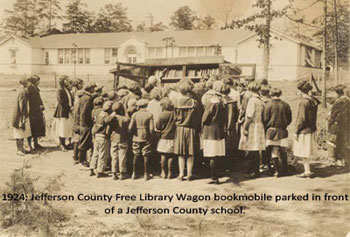 Prior to 1978, library services were divided with no central services and no overall plan. Each city library operated its own facility, served only its municipality, and had little or no contact with other libraries. Jefferson County public libraries served only their own municipalities, had their own library cards, and did not honor cards from other libraries in the county. There was a separate membership and a non-resident fee to use a library outside of a person's residential city. Residents of the unincorporated parts of the county did not have a local library at all and had to pay a fee to join one of the city libraries. Anyone tracking down a copy of a favorite book might have to spend an entire morning on the phone with different libraries. Also, this arrangement was inconvenient and expensive for each library to operate since there was much duplication of services.
Prior to 1978, library services were divided with no central services and no overall plan. Each city library operated its own facility, served only its municipality, and had little or no contact with other libraries. Jefferson County public libraries served only their own municipalities, had their own library cards, and did not honor cards from other libraries in the county. There was a separate membership and a non-resident fee to use a library outside of a person's residential city. Residents of the unincorporated parts of the county did not have a local library at all and had to pay a fee to join one of the city libraries. Anyone tracking down a copy of a favorite book might have to spend an entire morning on the phone with different libraries. Also, this arrangement was inconvenient and expensive for each library to operate since there was much duplication of services.
The Alabama Public Library Service (APLS) director at the time was Tony Miele; he was from Illinois, a state that had regional library systems. Miele's multi-type idea coincided with a growing national movement toward regional library systems that would collaborate to provide services. Alabama already had several countywide systems in place, however most were based on special legislation, which made collaboration difficult.
The directors of the Jefferson County libraries had been meeting for about 10 years at this point, and in 1974 informally organized as the Jefferson County Public Librarians Association. They held monthly meetings to share resources and discuss issues. Out of this effort, a sense of trust developed that encouraged the idea of cooperative library services. The first by-laws for the Jefferson County Public Librarians Association were written in the 1970s. The Jefferson County Librarians Association was renamed the Jefferson County Public Library Association (JCPLA) in 1980.
Preparing for Changes
The official movement toward cooperative services started when Jefferson County Commissioner Ben Erdreich asked George Stewart to investigate ways to improve library service for the entire county. Stewart saw Erdreich's inquiry as an opportunity to prepare a long-range plan for a countywide system. He worked with the directors and boards of the municipal libraries to develop a library system to serve all of Jefferson County.
In 1977, the boards of the various libraries agreed to try cooperative services. Most thought it unlikely that so many locally appointed officials would agree to work together and feared that local support would be reduced for the same reasons. However, no library at the time suffered a reduction in funding. Instead, each library saw an increase in usage from the beginning of the cooperation, and the directors and board members had a vested interest in providing the best public library services possible.
Stewart felt the cooperative would be the most effective way for Jefferson County to be successful in offering collaborative services. A contract approved by each municipal library board seemed the most non-threatening method to reach this goal and therefore had the best chance for success. Under the leadership of Stewart, the library directors and library boards from the various municipalities moved toward setting up a library cooperative. Board members authorized their directors and staff members to plan and work together to share resources, and they agreed to provide service to any resident of Jefferson County. They eliminated non-resident fees and other barriers to library use, and all public libraries were operated and funded by their municipalities.
A method for funding the services was needed to encourage the individual cities to share staff and resources. In 1977, Stewart asked the Jefferson County Commission to help fund this countywide effort that would improve library service for everyone in the county, even residents in unincorporated areas. That same year, the Commission agreed to fund certain portions of countywide library service for all county residents. The Commission's farsighted act was the single most important factor in making a countywide cooperative library system possible. The Commission voted to approve funding that would make it possible for libraries to share resources and materials countywide by van delivery, to implement one catalog, and to have one library card for use at all county libraries. Thus was born the
"One County, One Library Card" system that member libraries and all patrons in the county still use. Cooperation began in 1978, and the first contracts between member libraries were signed in 1980.
Upon the retirement of Lois Upshaw, Phil Teague, the Shelby County system head, left that position and joined Jefferson County in 1979 to lead the countywide library operation. Teague was responsible for the County Library collection held in the bookmobile center; two bookmobiles; the delivery system to the county libraries, which was located in the center; and for providing support to the county libraries. He reported directly to Stewart.
BPL maintained a county bookmobile until the early 1980s. By then, several additional libraries were providing countywide services at each local library facility. As cooperative services were made available to all residents of the county, the bookmobile service was no longer essential. The county's last bookmobile was retired in the early 1980s.
Looking to the future, county officials began a quest to identify high-growth areas in Jefferson County, and Alabama Power executives assisted by pinpointing sites that were expected to see significant growth. They identified the Huffman area, the Forestdale area and the almost-exact present-day site of the Hoover Library. Springville Road Library was built cooperatively in 1980 by the City of Birmingham and Jefferson County to serve residents of the eastern section of the county. A library in Forestdale was never realized because it was in an unincorporated area with no local city funding and the county would not assume the cost of construction with no municipal support. That regional proposal was then moved to the Ensley Library and later to the Five Points West Library. The Hoover Library was planned as a municipal library at the request of Hoover's Friends of the Library organization and Mayor Frank Skinner. It's interesting to note that Hoover's growth coincided with Alabama Power's projection.
1978 JCPLA Charter Member Libraries:
Charter member libraries in 1978 included Adamsville, Bessemer, Birmingham Botanical Gardens, Birmingham Public Library System, Fairfield (Walter J. Hanna), Fultondale, Gardendale, Graysville, Homewood, Irondale, Leeds, Midfield, Mountain Brook (Emmet O'Neal), Pleasant Grove, Trussville, Vestavia Hills, and Warrior.
In the early 1980s – Joined Later: Tarrant City and Hueytown. The Hoover Library opened a new library in 1983. The Fairfield (Walter J. Hanna), Western Hills Mall branch opened in 1995 and closed in 2004. The City of Clay opened a new library in 2009, and the Pinson Library opened in 2011.
Organizing a Cooperative
The Birmingham Area Library Service, Inc. (BALS) was established in 1985, and the first Articles of Incorporation were legally drawn up. The charter Executive Board was appointed, and the first by-laws were adopted under the BALS name. It was incorporated as a 501(c)(3) tax-exempt nonprofit organization.
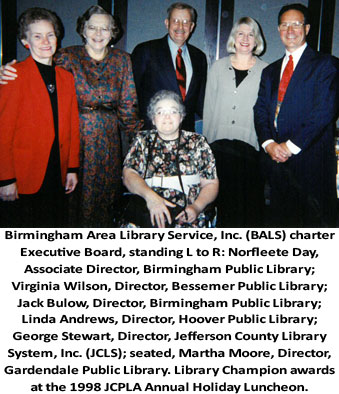 In 1982 JCPLA began purchasing equipment for computer use, and Stewart and the Executive Board decided that more funding was required to supplement the resources received from the County Commission. With the advent of telecommunications,
"port fees" were the natural method to begin the funding. The formula for member fees based on telecommunications expenses stayed in place until a new method, based on the Cleveland Public Library Consortium, was put in place in 2002. This formula, based on the number of PCs per library, holdings, and circulation was a more equitable model.
In 1982 JCPLA began purchasing equipment for computer use, and Stewart and the Executive Board decided that more funding was required to supplement the resources received from the County Commission. With the advent of telecommunications,
"port fees" were the natural method to begin the funding. The formula for member fees based on telecommunications expenses stayed in place until a new method, based on the Cleveland Public Library Consortium, was put in place in 2002. This formula, based on the number of PCs per library, holdings, and circulation was a more equitable model.
George Stewart retired in 1993 after serving for 16 years as director of BPL. His career spanned 33 years with the Birmingham Public Library System, during which he served as director and also steward for the county funding. Prior to Stewart's retirement, Norfleete Day had begun keeping the books for county funding.
At that point, the BALS name was changed to the Jefferson County Library System (JCLS) to better reflect the funding sources. The JCLS Executive Board (initially a five-member governing board) decided to hire Stewart as the JCLS director to coordinate cooperative operations, maintain the books, to hold regular directors' meetings, and to manage the concerns of JCLS. The five charter members of the JCLS Executive Board included Linda Andrews (Hoover), Jack Bulow (BPL), Norfleete Day (BPL), Martha Moore (Gardendale), Virginia Wilson (Bessemer), and Stewart as an ex-officio member.
The board created a county administrative office space on the fifth floor of the Linn-Henley building. Stewart also was given the task of coordinating an investigation of automated systems, and he worked with the directors and library staff to evaluate and demonstrate several of these systems. In 1996, they made a final decision to move from CLSI to Innovative Interfaces, Inc.
Stewart retired from JCLS in 1997, and the Executive Board appointed Patricia F. Ryan as director of JCLS. Ryan was given the task of hiring an administrative assistant to help run the JCLS operation.
When Ryan began her duties, two opportunities changed the face of libraries in the state. First, a grant from the Gates Library Foundation in 1998 provided computers to every public library in Alabama. Then the Universal Service Act (ERATE), a nationwide initiative approved by Congress, provided the funding necessary to assist libraries and schools in telecommunications. That gave Jefferson County libraries access to the growing Internet.
In 1999, the JCLS Executive Board approved new by-laws, which made the director of each library a member of the JCLS Board of Directors. In 2002, the Board of Directors voted to change the name from Jefferson County Library System, Inc. (JCLS) to the Jefferson County Library Cooperative, Inc. (JCLC) to better reflect the cooperation between member libraries.
By 2000, Jefferson County residents could walk into any public library and be connected to the Internet. Area libraries jointly purchased and operated a computer catalog and on-line periodical databases, allowing patrons to search countywide holdings. Patrons also had access to newspaper and magazine articles on all computers. The single automated circulation control system meant that county residents could make use of any library holdings and return materials and pay fines at any location in the county. A renewal hotline was installed to allow patrons to renew materials by telephone. A van delivery service allowed patrons to have requested materials delivered from any county library to the library of their choice for pick-up. Directors and library staff countywide coordinated many joint programs such as
The Reader newsletter publication, advocacy, and staff training. The cooperation between member libraries enabled all of Jefferson County's public libraries to make service more convenient, pleasant, and efficient for all patrons.
The Jefferson County Commission continued to generously fund JCLC through an occupational tax paid by anyone working in Jefferson County. When this occupational tax was challenged and ruled unconstitutional by the Alabama Supreme Court in 2009, the Commission immediately began trimming its budget by cutting many non-profit organization grants from operational expenses. Beginning in fall 2009, the JCLC Board made the decision to begin private fundraising. Ryan spearheaded the effort, and the first direct-mail campaign was
"Keep It Alive! One County—One Card!" Over the years, private donations have increased to provide a small subsidy to the annual budget. Thanks to the foresight of the Board of Directors, JCLC began growing its emergency fund several years prior to the final court ruling. This funding source sustained JCLC through those lean years and allowed the cooperative to continue to offer essential services to member libraries and the public. Nonetheless, the funding reductions resulted in Ryan and the JCLC Board of Directors working diligently to make major cuts in the cooperative budget. Persons living outside the county could join the cooperative for an annual fee. The out-of-county fees for membership in local libraries were increased from $35 to $50 in 2009. The increase allowed JCLC to receive $15 of each membership as a small subsidy to help offset the cuts.
In 2014, member library fees were increased 25 percent when emergency funds began dwindling. Normally, fees were raised 5 to 7 percent annually to offset inflation. The increase in member fees and cutting cooperative services expenses, including laying off JCLC staff, allowed JCLC to begin stabilizing resources and operating with a balanced budget again by 2015. The hope was that the county funding would eventually be restored at some level.
Jefferson County's Libraries Today
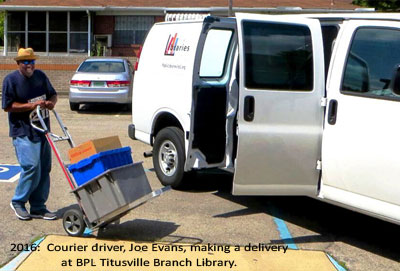 Today, library patrons are accustomed to using any of the 40 library locations, and they appreciate having easy access to the two million titles available from one of the South's finest library systems. Applications for library cards are available at any library and online, and one library card can be used at every library in Jefferson County. JCLC, in partnership with BPL, operates an Information Technology support department, which offers assistance to all member libraries. It also operates a delivery system with new replacement vehicles recently funded through grants from Jefferson County (2015/2016). These vehicles transport millions of items annually between the 40 county libraries.
Today, library patrons are accustomed to using any of the 40 library locations, and they appreciate having easy access to the two million titles available from one of the South's finest library systems. Applications for library cards are available at any library and online, and one library card can be used at every library in Jefferson County. JCLC, in partnership with BPL, operates an Information Technology support department, which offers assistance to all member libraries. It also operates a delivery system with new replacement vehicles recently funded through grants from Jefferson County (2015/2016). These vehicles transport millions of items annually between the 40 county libraries.
Patrons can sign up for computer classes offered at many libraries to learn basic computer skills. They can fill out job applications and compile resumes at their libraries, too. Students can find homework resources online and have easy access to statewide resources such as the Alabama Virtual Library; Learning Express Library; and Homework Alabama, which provides live tutors to assist with homework and job-skill training.
 The Jefferson County Library Cooperative remains a crucial service for the residents of the county. As public libraries continue to renew their vision and transform in the digital age, people throughout Jefferson County will benefit from the many services and resources offered through the cooperative. They also will benefit from the comprehensive knowledge and vast experience of the people working in their libraries. Libraries are
"growing organisms" (Ranganathan, 1931), and some users might occasionally find them complex and even confusing as more and more services and programs are added. Even regular visitors to a library might need help to inform and guide them through the maze of resources, services, and changes that libraries continually undergo. Member library staff throughout the cooperative are there to do that. With an eye to an exciting future and a respectful nod to an honored past, Jefferson County libraries and librarians will continue to serve generations of patrons in all of the county’s communities.
The Jefferson County Library Cooperative remains a crucial service for the residents of the county. As public libraries continue to renew their vision and transform in the digital age, people throughout Jefferson County will benefit from the many services and resources offered through the cooperative. They also will benefit from the comprehensive knowledge and vast experience of the people working in their libraries. Libraries are
"growing organisms" (Ranganathan, 1931), and some users might occasionally find them complex and even confusing as more and more services and programs are added. Even regular visitors to a library might need help to inform and guide them through the maze of resources, services, and changes that libraries continually undergo. Member library staff throughout the cooperative are there to do that. With an eye to an exciting future and a respectful nod to an honored past, Jefferson County libraries and librarians will continue to serve generations of patrons in all of the county’s communities.
Timeline
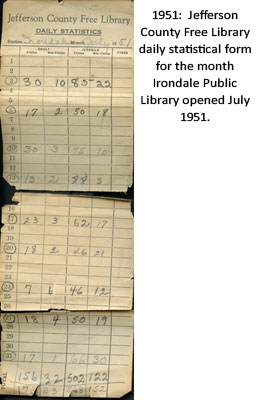 1886: *Dr. John Herbert Phillips, Superintendent of Schools [Birmingham City], conceived the idea of a library, which later became the nucleus of the [Birmingham] Public Library, for the use of teachers and students of Birmingham.
1886: *Dr. John Herbert Phillips, Superintendent of Schools [Birmingham City], conceived the idea of a library, which later became the nucleus of the [Birmingham] Public Library, for the use of teachers and students of Birmingham.
1891: *The school library became a "subscription library," with the public having access to the books for an annual $2.00 fee.
1909: *Subscription fee abolished, and the Birmingham Public Library declared
"free and forever after." Quarters were on the fourth floor of the old City Hall, and the book collection listed as containing 20,000
"bound volumes."
1918: *The Booker T. Washington Branch, the only Negro public library in Alabama, was established for the 80,000 Negro residents of the city.
1924: January 1 - The Jefferson County Free Library began bookmobile service to county residents, the service being administered by the Birmingham Library Board.
The contract between the Jefferson County Board of Revenue and the Birmingham Library Board took effect, beginning the long-standing relationship that today is Jefferson County Library Cooperative (JCLC). The first cooperative services funding began in 1924 when the Jefferson County Commission provided for bookmobile service to county residents.
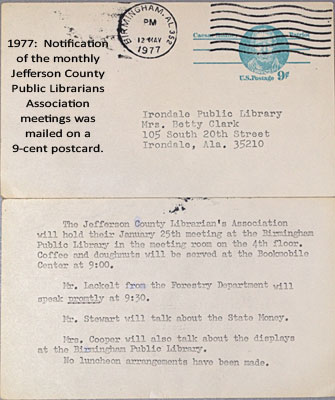 1927: *The present four-story [BPL] Central [Linn-Henley building], with a capacity for 300,000 volumes, was opened April 11th. Consisting of nine departments, it was the model public library building in the South.
1927: *The present four-story [BPL] Central [Linn-Henley building], with a capacity for 300,000 volumes, was opened April 11th. Consisting of nine departments, it was the model public library building in the South.
1952: *$11,000 was donated by Mrs. Horace Hammond for the purchase of the [BPL] Library’s first city bookmobile stocked with new books.
1956: *A new $115,000 branch library for Negroes, named the Smithfield Library, was opened in April.
*(50th Anniversary Historical Highlights, BPL Digital Collection)
Early 1970s: George Stewart, director of the Birmingham Public Library System (BPL), worked with library directors countywide to jumpstart the vision of a countywide library system. At this time, the Alabama Public Library System (APLS) was recommending that countywide systems be set up.
1970s: A limited number of libraries began using Recordak/microfilm for circulation.
1974: Jefferson County Librarians Association informally organized. The first by-laws were written, revised, and approved Nov. 28, 1978, and the organization’s name changed to Jefferson County Public Librarians Association.
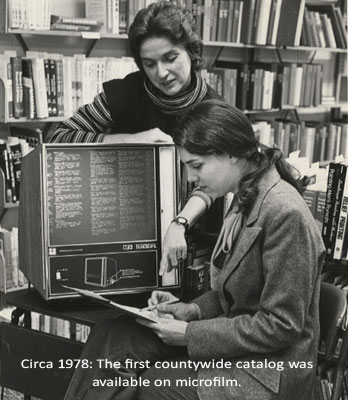 1977: A countywide catalog retrospective conversion project began with Autographics on film. Through the federal Comprehensive Employment
& Training Act (CETA) program, 22 employees began work on this project. CETA provided short-term employment to assist those who qualified and could use this experience to get "regular" jobs in the economy.
1977: A countywide catalog retrospective conversion project began with Autographics on film. Through the federal Comprehensive Employment
& Training Act (CETA) program, 22 employees began work on this project. CETA provided short-term employment to assist those who qualified and could use this experience to get "regular" jobs in the economy.
1978: Formal consortium governance structure was put in place after Stewart requested funding from the Jefferson County Commission. The first Commission funding check was received in 1978.
1980: The Jefferson County Public Librarians Association by-laws were revised January 1980 to change the name to the Jefferson County Public Library Association (JCPLA).
1980: October 1. Under Stewart’s direction, the first contract was signed between member libraries that entered into ‘An Agreement to Provide Library Service on a Cooperative Basis in Jefferson County’.
This was the beginning of what would become the Jefferson County Library Cooperative.
1980: Began cataloging as a member of the OCLC Network.
1982: Member fees implemented using telecommunications ports for calculations, and 17.5 percent was taken from member libraries’ state aid for cooperative services.
- When Stewart began purchasing equipment for computer use, etc., he and the Executive Board decided that
"access fees" were required to supplement the funding received by the Jefferson County Commission. With the advent of telecommunications,
"port fees" were the natural method to begin assessing member fees. The formula for member fees was based on telecommunications expenses, and this stayed in place until a new method based on the Cleveland Public Library Consortium model was put in place in 2005. The new formula—based on the number of PCs per library, holdings, and circulation—was a more equitable model.
- Each library received state aid based on population. These funds were distributed quarterly by Stewart. After approval by member libraries’ boards, 17.5 percent of state aid funds were withheld from members for cooperative services.
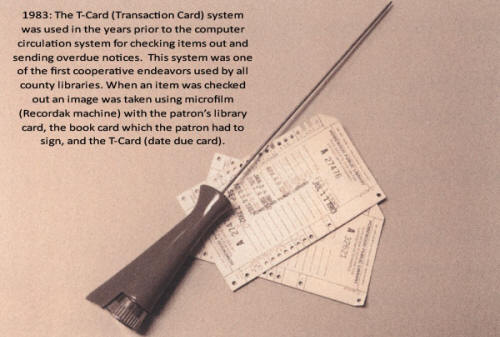 1982: BPL staff began training to enter bibliographic records and items into CLSI. Circulation started slowly on CLSI by location, as each library added enough of its collection to make it worthwhile. The training and data entry went on for years. BPL-Central started circulating online the weekend of the grand opening of the East Building, September 1984. There was no
"countywide" circulation at first. Online circulation began, library-by-library, as materials were barcoded and entered, equipment was purchased and installed, and staff were trained. Each library received at least one full week of onsite assistance from Central staff, and then BPL staff took over being the onsite presence when a library or branch came on-line.
1982: BPL staff began training to enter bibliographic records and items into CLSI. Circulation started slowly on CLSI by location, as each library added enough of its collection to make it worthwhile. The training and data entry went on for years. BPL-Central started circulating online the weekend of the grand opening of the East Building, September 1984. There was no
"countywide" circulation at first. Online circulation began, library-by-library, as materials were barcoded and entered, equipment was purchased and installed, and staff were trained. Each library received at least one full week of onsite assistance from Central staff, and then BPL staff took over being the onsite presence when a library or branch came on-line.
1985: February 28. Birmingham Area Library Service, Inc. (BALS)
was established. First Articles of Incorporation were legally drawn up. The Executive Board was appointed, and the first by-laws were adopted under the BALS name. BALS incorporated as a 501(c)(3) tax-exempt nonprofit organization. The charter members of the Executive Board were Linda Andrews (Hoover), Jack Bulow (BPL), Norfleete Day (BPL), Martha Moore (Gardendale) and Virginia Wilson (Bessemer). George Stewart served as Secretary/Treasurer in an ex-officio capacity, while at the same time serving as the director of the BPL System.
BALS History: Initially adopted by-laws February 1985, and Articles of Incorporation certified February 28, 1985 as Birmingham Area Library Service.
1988:
First countywide email system was set up.
1992/1993: Libraries were still connecting to CLSI, and training continued in 1992. In 1993, the BPL-Catalog Dept. took over responsibility for adding all final bibliographic records to the catalog.
1993: George Stewart retired as director of the BPL system after 16 years. He had spent a total of 33 years with the BPL.
1993: The Birmingham Area Library Service (BALS) Executive Board appointed Stewart as the first director of the BALS. Stewart began work with directors selecting the next Integrated Library System (ILS). In 1996, the Executive Board approved the move to Innovative Interfaces, Inc.(III).
1993-1994: Converted the online catalog to MARC in the migration to CLSI’s Libs+ system.
1996: Purchased Innovative Interfaces for $627,213. JCLS was able to do this due to the 1985 501(c)(3) incorporation, which enabled JCLS to take out a bank loan to be paid back in installments.
1996: June. Began loading bibliographic records, patron records, and some circulation history and began circulating in November 1996.
1997: June 19. The BALS Articles of Incorporation were amended, and the name was changed to the
Jefferson County Library System, Inc. (JCLS) to better reflect and give credit for the funding provided by Jefferson County. Stewart retired from JCLS in July 1997.
1997: August. Patricia (Pat) Ryan was appointed director of JCLS.
1998: In 1998 the member libraries of JCLS only had 425 computers for public/staff use countywide. The Gates Library Foundation grant provided for the purchase of additional public PCs for all member libraries. JCLS libraries went online with Gates Library Foundation PCs in 1999. Jefferson County libraries received equipment in the amount of $578,156 for 329 computers, printers, routers, and upgrades. In 2003 the number of computers increased dramatically to 1,012 countywide, a 138% increase. By 2017 JCLC would have 1,456 PCs in 40 libraries countywide.
1998: JCLS celebrated "20 Years of Cooperation."
1999: The JCLS charter Executive Board approved new by-laws that made the director of each library a member of the newly formed Board of Directors. The Executive Board became an advisory committee.
2000: Alabama Virtual Library was established. Alabama was one of the first in the country to provide databases statewide.
2000: An LSTA grant funded an upgrade to Innovative Millennium system.
2001: The Innovative bank loan was paid off four years early.
2002: July 26. The Board of Directors voted to change the name from Jefferson County Library System, Inc. to the Jefferson County Library Cooperative, Inc. (JCLC) to better reflect the cooperation between member libraries.
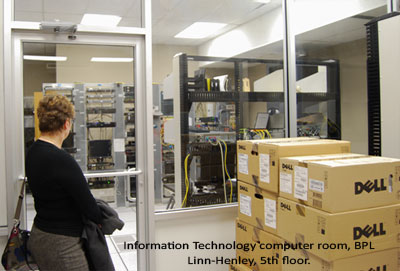 2002: The portion of state aid received for cooperative services had remained at 17.5 percent since the first contracts were signed by member libraries in 1980. An increase of 12.5 percent—from 17.5 to 30 percent—was recommended and became effective on October 1, 2002.
2002: The portion of state aid received for cooperative services had remained at 17.5 percent since the first contracts were signed by member libraries in 1980. An increase of 12.5 percent—from 17.5 to 30 percent—was recommended and became effective on October 1, 2002.
2004: Turned on Patron Placed Holds.
2005: A new member fee model, based on the Cleveland Public Library Consortium, was adopted and went into effect.
2005: Homework Alabama began offering free, live tutors for homework help. Alabama was the first in the nation to purchase this resource statewide.
2005: The majority of libraries began loaning media countywide.
2006: Began downloadable eBook & eAudio collection with Overdrive.
2008: JCLC earned the Alabama Library Association achievement of library system standards at the Gold Star level, as measured by A Plan for Excellence: Standards for Public Library Service in Alabama, Systems Standards published in 2003. Also, a Resolution from the Jefferson County Commission recognized JCLC’s outstanding award for achievement.
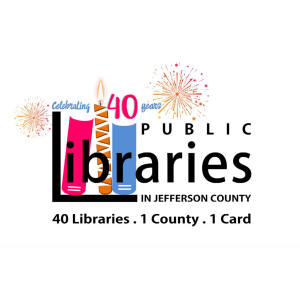 2008: Jefferson County NEA Big Read: Project Mockingbird, NEA grant.
2008: Jefferson County NEA Big Read: Project Mockingbird, NEA grant.
2008: Implemented e-commerce payments for fines/lost materials.
2009: JCLC private fundraising began.
2010: Statewide NEA Big Read: Alabama Reads—The Adventures of Tom Sawyer.
2012: Innovative upgrade to Sierra; funded by LSTA grant monies.
2013: JCLC received an award from the Birmingham Business Journal in the Nonprofit $250,000 to $1 Million Revenue category.
2013-2015: Joint grant with Shelby County – Financial Industry Regulatory Authority (FINRA)/Public Library Association – Smart investing@your library —
"Making Cents: Resources to help your money grow."
2018: The Public Libraries In Jefferson County celebrate 40 years of cooperation!
Names of the organization:
1924: Jefferson County Free Library
1974: Jefferson County Librarians Association
1978: Jefferson County Public Librarians Association
1980: Jefferson County Public Library Association (JCPLA)
1985: Birmingham Area Library Service, Inc. (BALS)
1997: Jefferson County Library System, Inc. (JCLS)
2002: Jefferson County Library Cooperative, Inc. (JCLC)
2013: JCLC created a new logo and began using the name Public Libraries In Jefferson County (PLJC) for publicity purposes. However, the library cooperative retained the legal name d/b/a Jefferson County Library Cooperative, Inc., for business purposes.
Jefferson County Library Cooperative Historical Committee
Del Wilson, Chairman, Irondale Public Library
Virginia Allen, Hueytown Public Library
Deborah Fout, Homewood Public Library
Pat Ryan, Jefferson County Library Cooperative
Mary Stewart, Birmingham Public Library
Compiled and Printed December, 2017
Printing Compliments of the Jefferson County Public Library Association
Mary Anne Ellis (BPL), President, JCPLA